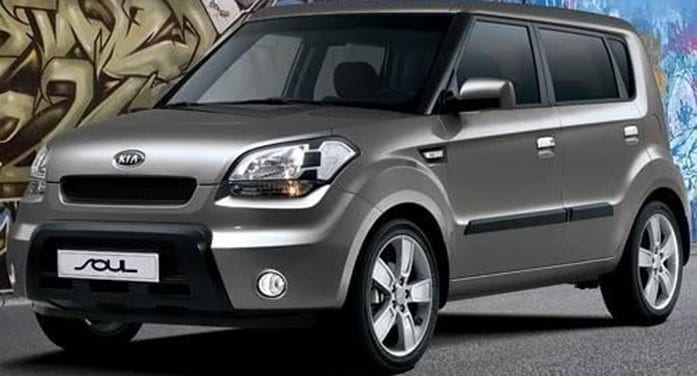 The Kia Soul was introduced to the North American market in 2010.
The Kia Soul was introduced to the North American market in 2010.
Based on the Rio platform, it was one of the new breed of stubby compact urban crossover wagons, such as the Nissan Cube, Scion xB, Honda Element, Ford Flex and so on. When it hit the market, Kia was also targeting the Dodge Caliber and Suzuki SX4 as rivals. You could also toss the Pontiac Vibe and Toyota Matrix in there.
In 2011, two engines were offered, both four-cylinder. The 1.6-litre version developed 122 horsepower, while the 2.0-litre was good for 142 horses. You could choose from a four-speed automatic or five-speed manual transmission, but the manual gearbox came standard with the smaller engine.
High on the cuteness scale, the Soul did have a practical side. Fold down the back seats and you got 546 litres of cargo space and there was an abundance of rear legroom and headroom throughout the vehicle. Backseat elbow room and ingress/egress was surprisingly ample, which isn’t always the case with these kinds of puddle-jumpers.
Both on the highway and around town, the Soul surprised with its reserve power, nimbleness and, in particular, its lack of rattles, looseness or mysterious noises. Kia has kind of a checkered history when it comes to things like assembly quality but the Soul seemed to be as tight as a drum.
But it did feature an overly stiff ride.
Four versions were offered: 2u, 4u, 4u Retro and 4u Burner. Depending upon the model, you could order things like larger wheels and tires, sportier suspension, upgraded stereo, sunroof, different-coloured interior trim, air conditioning and stereo speakers with a mood lamp feature. Crank up the tunes and they glow red in time to the music – what Kia called a “club effect.” You could also choose upholstery that glows in the dark.

High on the cuteness scale, the Soul did have a practical side. Kia has kind of a checkered history when it comes to things like assembly quality but the Soul seemed to be as tight as a drum
Standard equipment included the usual roster of modern conveniences, such as power door locks, heated mirrors, Bluetooth capability, USB ports and heated front seats. This last feature was – and is – an excellent idea and should be standard on all cars sold in Canada.
Kia also offered a range of performance upgrades that included high-flow air filter, tuned exhaust and high-performance air intake.
There was one safety recall to report from Transport Canada and it concerned the sound system. Apparently, the wiring harness may contain faulty soldering that could cause the illuminated speaker system to short out and, in a worst case scenario, cause a fire. This glitch could also apply to Kia Sorento models of the same year.
The National Highway Traffic Safety Administration in the U.S., meanwhile, had eight technical service bulletins. These included issues with the fuel filler cap, a squeaky rear window washer, difficulties getting into first gear with the manual transmission, issues with the variable valve timing system and various minor electrical gremlins.
Consumer Reports was cautiously positive. They liked its affordability and “decent” performance, but had reservations about the stiff ride and “basic” interior. Some comments from owners:
- “While driving on highway, all four brakes activated without brakes being pressed. Vehicle decelerated from 65 mph to 30 mph and driver’s side front brake caught on fire.”
- “When putting the vehicle into reverse and releasing the clutch out to start moving, the vehicle makes a loud metallic moaning sound.”
Marketing researcher J.D. Power was mostly positive – but not completely. They liked the Soul’s body and interior quality, and features and instrumentation, but had misgivings about the powertrain quality and overall performance. It got a “better than most” rating for overall performance and design, and an “about average” grade for predicted reliability.
From a base price of around $15,500 in 2011, prices these days seem to range from about $5,000 for the base 2u, to around $7,000 to $8,000 for a fully-loaded 4u Burner SX version. The larger engine models fetch slightly more than the base 1.6-litre models.
2011 Kia Soul
Original base price: $15,495
Engine: 1.6- and 2.0-litre four cylinder
Horsepower/torque: 122 and 142/115 and 137
Transmission: Four-speed automatic or five-speed manual
Fuel economy (litres/100 km): 8.5 city, 6.6 highway, with automatic transmission and 2.0-litre engine, using regular gas
Some alternatives: Honda Element, Toyota Matrix, Pontiac Vibe, Chevrolet HHR, Chrysler PT Cruiser, Dodge Caliber, Suzuki SX4 hatchback
Ted Laturnus has been an automotive journalist since 1976. He was named Canadian Automobile Journalist of the Year twice and is past president of the Automobile Journalists Association of Canada (AJAC). For interview requests, click here.
The views, opinions and positions expressed by columnists and contributors are the authors’ alone. They do not inherently or expressly reflect the views, opinions and/or positions of our publication.
© Troy Media
Troy Media is an editorial content provider to media outlets and its own hosted community news outlets across Canada.


